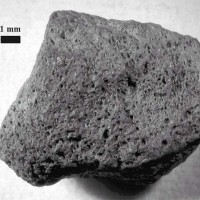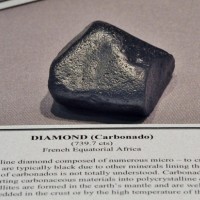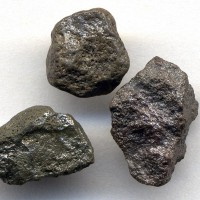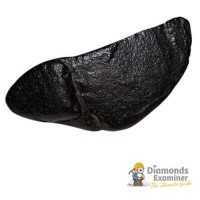Top 10 Facts About the Mysterious Black Diamond (Carbonado, Carbonado Diamond)
For me Black Diamond is the most mysterious diamond and perhaps the most mysterious gem ever. There are many differences between conventional diamonds and black diamonds. Black Diamonds / Carbonados do have unusual properties that are hard to explain without including theories about their extraterrestrial origin. According to these theories Black Diamonds have formed in outer space and have traveled to Earth with asteroids.Things are more complicated than they look on this list but in this list I can't include all details, scientific analyses, and all pros and cons. Studies and analyses of this gem are doing on.

Like all diamonds, its hardness is 10/10 (I.e. same resistance to scratching). But being the toughest form of diamond means it is the most resistant to mechanical shock, I.e. it doesn't break or crack easy when hit with a hammer, or it breaks less easy than the other diamonds. Black diamonds are extremely difficult to cut and polish.
Your knowledge about gemstones is amazing!

Stephen Haggerty, a geologist at Florida International University in Miami, US, says that their porous structure was one of the features that "first led some of us to think, well, perhaps there has to be a different alternative" (because it's hard to explain how gas became trapped in rocks).
Haggerty and his colleagues believe that black diamonds came from a large, diamond-bearing asteroid that crashed to Earth from space. They also think that black diamonds formed from diamond dust released when a star exploded in a supernova. This explains those tiny diamond crystals (dust) stuck together and the pores.

Black diamonds have many unusual properties and these gems might be a result of formation that includes different/unusual conditions, probably in outer space.
Most scholars seem to agree with that. Well, a difference of 1,000 and even 100,000 years looks insignificant when we talk about 3 billion years. Currently the biggest question is WHERE did this crystallization happen (on Earth or not? ) and not WHEN did it happen.
Crystallization is the process when diamonds form crystals from surrounding materials.

Some say black diamond is ONLY found in these 2 regions, wiki including. But some say that a chunk was found in India and another one in Russia. I can't say who is right. But one thing is sure - not in many locations.
Stephen Haggerty from Florida International University in Miami, US, explained that when the large asteroid with black diamonds landed on Earth, South America and Africa were one land mass, which could account for the diamonds showing up on two continents today.
All these theories are hypotheses and not facts but it's a fact the theories exist so this is a legit item.
None of these 6 theories was widely accepted, including the 4 theories about the extraterrestrial origin. You understand that nothing is 100% sure but it might be true because:
We already know that meteorites and asteroids are facts and not fictions, we also know that some meteorites and asteroids came to earth with gems on them. And we also know for sure that there are gems on Mars, on the Moon, comets, and other celestial bodies (I made lists about it). So it isn't completely nonsensical to assume that a gem (black diamond) came from space. Many other gems did come from space so I don't see a reason to exclude the theories of carbonado's extraterrestrial origin.
I added items with some of the unusual properties of carbonado to show that many things are hard to explain without including space.
Because black diamond isn't found in many locations on Earth, it wasn't hard to check and... in neither
place carbonado diamond was associated with kimberlite, the source of typical gem diamonds. Black diamond has never been discovered in the conventional Kimberlite diamond mines of South Africa, Canada, Australia or Russia. If it never occurs in Kimberlite and Lamproite pipes, it doesn't come from deep inside the earth like conventional diamonds.
So probably black diamonds did not form hundreds of miles below the surface of the Earth (in Earth's mantle) where the conditions turn carbon into diamonds. Black Diamonds probably came from space with asteroids and the conditions of their formation were different than those in Earth's mantle where other diamonds form.
These inclusions from the Earth's crust (surface) do not prove formation of the black diamonds in the crust
because these mineral inclusions may have been introduced after carbonado formation. Also, it's hard to explain how exactly did diamonds form in the Earth's crust when diamonds form in the Earth's mantle.
Atypical inclusions found in black diamonds lead again to some of the theories about the extraterrestrial origin - according to some of these theories a large mass with black diamonds fell on Earth about 2.3 billion years ago and this explains why black diamonds are more related to the Earth's crust than Earth's mantle. Black diamonds stayed in the Earth's crust pretty long and had enough time to absorb some minerals from the Earth's crust.
This finding somewhat eliminates one of the theories about the extraterrestrial origin - the one that explains carbonado formation ON Earth due to asteroid impact. There are diamonds (but not black) formed this way on Earth - it's when an asteroid hits the Earth and the shock pressures instantly turn the carbon (mainly graphite) in the rocks into diamonds. They are called Asteroid Impact Diamonds, like the ones in the Popigai Crater, in Siberia, Russia. I still can't exclude completely this hypothesis though.
However, lack of high-pressure minerals (such as the hexagonal carbon polymorph, lonsdaleite, etc.) in black diamond kinda excludes its formation on Earth due to a shock asteroid impact.
So carbonado diamonds probably didn't form in the Earth's mantle, probably didn't form on Earth due to asteroid impact... Again, most probably black diamonds formed in space and came to Earth WITH an
asteroid.

Too many unusual properties, too many differences between conventional diamonds and black diamonds. At this point it's harder to explain how carbonado formed on Earth than how it formed in space.
The explanation of the supporters of the extraterrestrial origin is:
Black diamonds formed from diamond dust released when a star exploded in a supernova. Black diamond's material source was a supernova which occurred about 3 billion years ago. And "after coalescing and drifting through outer space for about one and a half billion years, a large mass fell to earth as a meteorite approximately 2.3 billion years ago."
Black diamonds might be the aliens of the gemstone family.
For example, osbornite is almost exclusively found in meteorites, originally formed in star dust.


It weighs 3,167 carats, or 61 carats heavier than the largest clear diamond, the Cullinan, which was found in 1905 in South Africa.